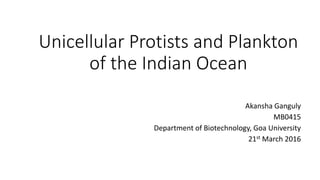
Marine Plankton of the Indian Ocean
- 1. Unicellular Protists and Plankton of the Indian Ocean Akansha Ganguly MB0415 Department of Biotechnology, Goa University 21st March 2016
- 2. What are protists? • Eukaryotes • Mostly unicellular • Two broad sub-groups – 1. Algae (autotrophic) 2. Protozoa (heterotrophic) • Reproduce asexually (binary fission) and sexually (gametes) • Found in water bodies • Commonly pathogenic or part of plankton
- 3. What are plankton? • Diverse group of microscopic organisms-live in large water bodies-cannot swim against a current • Include- 1. Phytoplankton (autotrophic, prokaryotic/eukaryotic algae, e.g. diatoms, cyanobacteria, dinoflagellates) 2. Zooplankton (protozoans) 3. Bacterioplankton (bacteria/archaea) 4. Mycoplankton (fungi/fungus-like) • Important food source
- 4. Primary productivity • Autotrophs: phytoplankton, macroalgae, marine bacteria • “Standing crop”: measure of total phytoplankton biomass in terms of chlorophyll content/numbers/cell volume in unit volume • Phytoplankton cell size: 1µm (flagellate) – 2mm (large diatoms) • Net plankton (retained by 63 µm net) and nanoplankton • Availability depends on degree of nutrient recycling from deep waters to surface (upwelling, turbulence)
- 5. • Winter – wind induced turbulence, phytoplankton growth reduces • Spring – increase in irradiance, length of day, winds become moderate, outburst of phytoplankton blooms • Indian Ocean: unique reversion of surface circulation in northern part every half year (north-east and south-west monsoon circulation) • SW monsoon upwelling in Arabian Sea: west coast blooms of diatoms such as Fragillaria, Coscinodiscus, Chaetoceros, Thalassiothrix, Pleurosigma, Rhizosolenia and Skeletonema • Phytoplankton biomass and productivity higher in coastal waters than deep seas due to shallow benthos (better upwelling) • Trichodesmium erythraeum blooms on offshore waters from February to May • “Mass forms” – bulk of flora on west coast- 29 species of Bacillariophyceae, 7 species of Dinophyceae and 1 of Cyanophyceae
- 6. Phytoplankton in the Arabian Sea Source: Understanding the Indian Ocean – Rao and Griffiths
- 7. • Northern Bay of Bengal highly productive during NE monsoons • Abundance of phytoplankton due to high-nutrient discharge from rivers on east coast 135 phytoplankton subspecies belonging to 2 species of cyanobacteria, 78 species of diatoms, 53 species of dinoflagellates and 1 species of silicoflagellate Oscillatoria erythraea , Proboscia alata - dominant species in all areas Pseudonitzschia pseudodelicatissima high density blooms in the Northern Bay (Chaetoceros messanensis as associated species)
- 8. Source: Boonyapiwat et al, 2007.
- 9. Zooplankton • General term for drifting animal populations in the water column, present in all regions of the ocean • Tropical zooplankton generally smaller than temperate zooplankton (short generation time, high metabolic requirements) • Mostly invertebrates (microscopic ciliates to metres long medusa) • Distribution and abundance closely connected to phytoplankton (limiting factor) • Herbivores, carnivores, detritivores, omnivores
- 10. Source: The Indian Ocean: A Perspective, Volume 2 – Rabin Sen Gupta
- 11. • Biomass distribution differs at upwelling, coastal waters and offshore waters and at various depths • Abundance more in coastal belt as compared to offshore seas • Pleuston: living at sea surface with part of body projecting in air (Porpita, Physalia, Velella, Ianthina) • Neuston: assemblage of zooplankton, closely associated with immediate surface film of the ocean • Neuston organisms: small-medium size, all taxa, serve as feeding layer for fish larvae • Reduction of predation pressure but limited food availability • Vertical migration: zooplankton move up-down the water column regularly, caused due to changes in light intensity, food availability, life cycle stage development etc.
- 12. • Copepods dominate zooplankton populations throughout the ocean • Arabian Sea: SW monsoon- highest numbers in eutrophic upwelling waters, lowest in offshore waters Aloricate ciliates (44 species such as Strombidium spp and Strobilidium spp), tintinnids (Amphorella, Dictyocysta, Rhabdonella etc.), metazoan nauplii etc.
- 13. Source: Veronica et al.,2007
- 14. • Zooplankton are good bio-geo indicators of a water body… e.g. Sagitta sp. (chaetognath) indicates salinity incursion in Indian estuaries planktonic foraminifera are good ecological indicators (Globigerina spp occupy distinct latitudes) copepods dominate areas of rich phytoplankton production, etc.
- 15. References • The Indian Ocean: A Perspective, Volume 2 - Rabin Sen Gupta (2001) • Understanding the Indian Ocean: Perspectives on Oceanography – T.S.S. Rao and Ray C. Griffiths (1998) • Mesozooplankton community in the Bay of Bengal (India): spatial variability during the summer monsoon. V Fernandes and N Ramaiah. Aquat. Ecol., vol.43(4); 2009; 951-963 • Composition, Abundance and Distribution of Zooplankton in the Bay of Bengal. I Jitlang, S Pattarajinda, R Mishra, L Wongrat. The Ecosystem-Based Fishery Management in the Bay of Bengal; 65-92 • The structure of zooplankton communities, in the 2 to 2000 µm size range, in the Arabian Sea during and after the SW monsoon, 1994. CE Stelfox, PH Burkill, ES Edwards, RP Harris, MA Sleigh. Deep-Sea Research, vol.46(II); 1999; 815-842 • Species Composition, Abundance and Distribution of Phytoplankton in the Bay of Bengal. S Booonyapiwat, MN Sada, JK Mandal and MK Sinha. The Ecosystem-Based Fishery Management in the Bay of Bengal; 53-64 • Phytoplankton composition and biomass across the southern Indian Ocean. L Schluter, P Henriksen, TG Nielsen, HH Jakobsen. Deep-Sea Research, vol.58 (I); 2011; 546–556